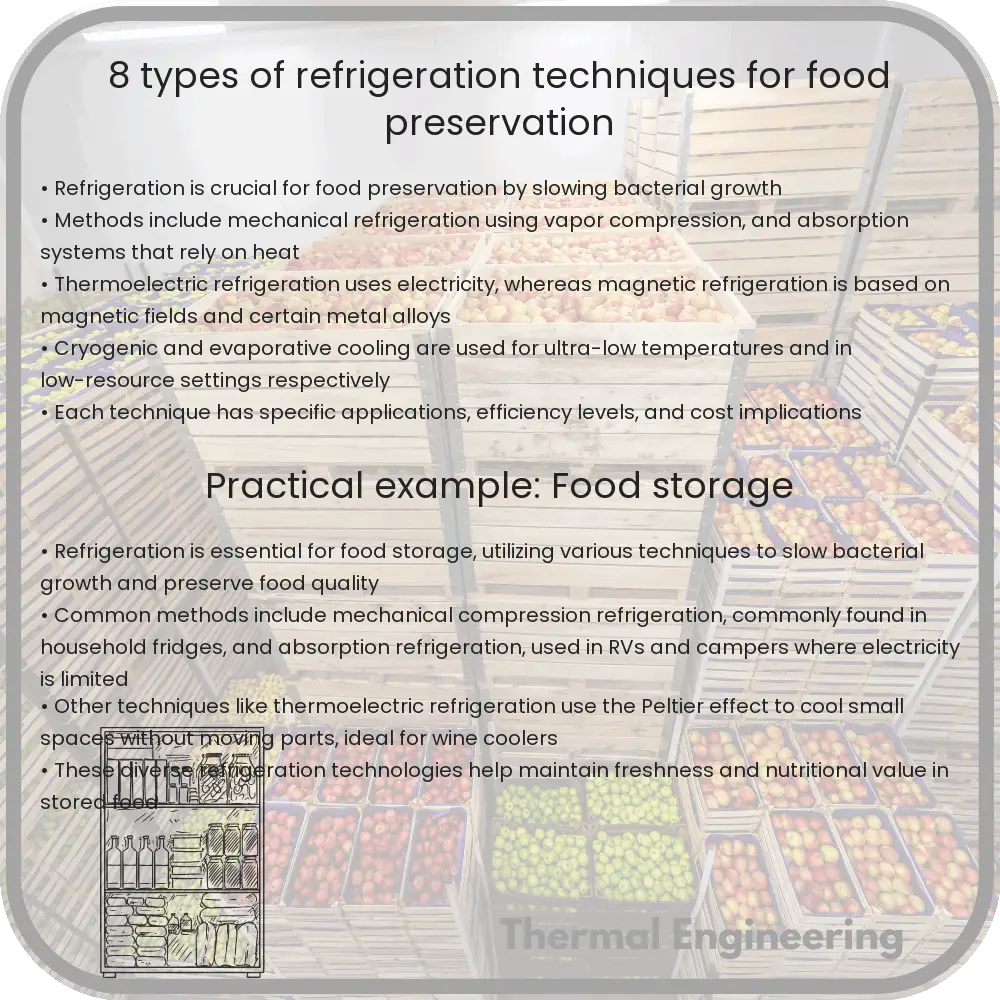Learn about eight essential refrigeration techniques for food preservation, from mechanical systems to innovative magnetic and cryogenic methods.

8 Types of Refrigeration Techniques for Food Preservation
Refrigeration is a critical process in food preservation, helping to keep perishables like fruits, vegetables, dairy products, and meats fresh for longer periods. This technology slows down the activity of bacteria, thus delaying spoilage and maintaining nutritional value and flavor. Here, we explore eight fundamental refrigeration techniques used in food preservation.
1. Mechanical Compression Refrigeration
The most common form of refrigeration, mechanical compression refrigeration systems work by compressing a refrigerant, then allowing it to expand, which cools it. The cycle involves evaporation, compression, condensation, and expansion of the refrigerant in a closed system. Typically used in household refrigerators and air conditioning units, this technique is effective for controlling the temperature with high precision.
2. Absorption Refrigeration
Absorption refrigeration uses a heat source to provide the energy needed to drive the cooling process. This system utilizes a refrigerant, which is absorbed by a secondary fluid called an absorbent. Heat is applied, causing the refrigerant to evaporate from the absorbent, and then it is condensed and evaporated in a cycle, producing a cooling effect. This type is most often used in industrial applications and refrigerators powered by gas, such as those in RVs.
3. Thermoelectric Refrigeration
This form of refrigeration uses the Peltier effect, which occurs when electricity is passed through a circuit of two different materials, creating a temperature difference. The heat is absorbed from one side of the device (cooling the interior) and transferred to the other side. Thermoelectric refrigerators are popular for portable cooler applications and small cooling systems.
4. Evaporative Cooling
Evaporative cooling is based on the principle that water requires heat to evaporate. In this system, air passes through a moistened pad, and as the water evaporates, it draws heat from the air, cooling it. This type of cooling is especially effective in dry climates and is used in cooling towers and some types of air conditioners.
5. Magnetic Refrigeration
Magnetic refrigeration is an innovative technology that cools materials through the magnetocaloric effect. When a magnetic material is placed in a magnetic field, it heats up. Removing the field causes it to cool down. Reciprocating this process can produce a refrigeration cycle that is highly efficient and environmentally friendly. It’s currently under development and research for practical applications.
6. Vapour Injection Refrigeration
Enhancing the efficiency of traditional heat pump and refrigeration cycles, vapor injection involves injecting refrigerant vapor into the compression cycle, reducing compressor work and improving efficiency. This technique is mostly seen in advanced commercial refrigeration systems.
7. Jet Refrigeration
Jet refrigeration, also known as ejector refrigeration, uses a high-speed jet of fluid to cool an area. This technique can employ various fluids but is often based on water or air and does not involve moving parts, making it less susceptible to mechanical failure. It’s particularly used in circumstances requiring the cooling of large volumes, like industrial facilities.
8. Cryogenic or Low-Temperature Refrigeration
Cryogenic refrigeration involves extreme cold temperatures, often below -150 degrees Celsius (-238 degrees Fahrenheit). It uses substances like liquid nitrogen or solid carbon dioxide (dry ice) to achieve these temperatures, primarily in the transport and preservation of medical supplies or highly perishable goods.
Each of these refrigeration techniques has specific applications, advantages, and limitations. The choice of which to use typically depends on factors like the intended application, efficiency, cost, and environmental impact. Understanding these various methods helps in selecting the right refrigeration technology for food preservation and other needs.